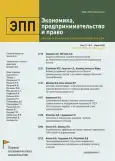Corporate bankruptcy and crises: analysis and trends
- Authors: Devyatkin O.V.1
-
Affiliations:
- Plekhanov Russian University of Economics
- Issue: Vol 13, No 7 (2023)
- Pages: 2329-2340
- Section: Articles
- URL: https://journals.eco-vector.com/2222-534X/article/view/607682
- DOI: https://doi.org/10.18334/epp.13.7.118472
- ID: 607682
Cite item
Abstract
The author analyzes the official statistics on the bankruptcy of organizations for 2022 and the Q1 of 2023 and draws conclusions about the trends in the development of the crisis situation in 2023. The analysis of the main indicators allows to conclude that the number of bankruptcies in the current 2023 is likely to increase. It is noted that there is a disproportionately large number of bankruptcy proceedings in comparison with the number of procedures aimed at restoring solvency, financial recovery and rehabilitation of debtors.As a result, creditors do not receive reimbursement of their claims, which is assessed as a direct loss. In addition, economic ties and supply chains are disrupted, which negatively affects the economy as a whole. It is proposed to discuss at the legislative level the possibility of conducting a mandatory financial recovery procedure for certain categories of debtors. Consideration of data on the total number of conclusions on the presence of signs of deliberate and fictitious bankruptcy is small, which indicates a real crisis state of enterprises and organizations. To prevent bankruptcies as an extreme manifestation of the crisis, it is proposed to apply a conceptually new innovative direction for ensuring strategic sustainable development. It is the mechanism of autogenic self-generated. In other words, controlled crisis.
About the authors
Oleg Vladimirovich Devyatkin
Plekhanov Russian University of Economics
Email: devyatkin.ov@rea.ru
References
- Единая межведомственная информационно-статистическая система (ЕМИСС) - государственный источник актуальных и достоверных статистических данных, получаемых из ведомственных хранилищ данных. [Электронный ресурс]. URL: http://www.fedstat.ru/indicators/start.do (дата обращения: 16.06.2023).
- Единый федеральный реестр юридически значимых сведений о фактах деятельности юридических лиц, индивидуальных предпринимателей и иных субъектов экономической деятельности (Федресурс). Статистический бюллетень Федресурса по банкротству, 31.12.2022, с. 28. [Электронный ресурс]. URL: :http://www.fedresurs.ru/news (дата обращения: 16.06.2023).
- Единый федеральный реестр юридически значимых сведений о фактах деятельности юридических лиц, индивидуальных предпринимателей и иных субъектов экономической деятельности (Федресурс). Сводные результаты процедур, применявшихся в деле о банкротстве на основе обработки сведений из опубликованных отчетов арбитражных управляющих за 1 кв. 2023 года. [Электронный ресурс]. URL: https://fedresurs.ru/news/cf80dd43-0e6f-411f-a2ed-2fa8735f5300 (дата обращения: 31.05.2023).
- Единый федеральный реестр юридически значимых сведений о фактах деятельности юридических лиц, индивидуальных предпринимателей и иных субъектов экономической деятельности (Федресурс). Банкротства в России: I квартал 2023 года. Статистический релиз Федресурса по банкротству, 31.03.2023, с. 10. [Электронный ресурс]. URL: http://www.fedresurs.ru/news (дата обращения: 31.05.2023).
- Экономические кризисы. / Большая советская энциклопедия. в 30-ти т. – 3-е изд. - М. : Советская энциклопедия, 1969 - 1986.
- Березинец И. В., Бобылева А. З., Ильина Ю. Б. Вероятность банкротства: достоверны ли модели прогнозирования? // Государственное управление. Электронный вестник. – 2022. – № 94. – c. 68-83. – doi: 10.24412/2070-1381-2022-94-68-83.
- Бобылева, А. З., Львова О. А. Финансово-экономический инструментарий выявления признаков объективного банкротства // Актуальные проблемы экономики и права. – 2020. – № 1. – c. 22–39. – doi: 10.21202/1993-047X.14.2020.1.22-39.
- Девяткин О. В. Аутогенный кризис как концептуальная модель системных изменений // Вестник РЭУ имени Г. В. Плеханова. – 2019. – № 2 (104). – c. 182-191. – doi: 10.21686/2413-2829-2019-2.
- Девяткин О. В. Стресс-тестирование в системе аутогенного кризиса // Научные исследования и разработки. Экономика фирмы. – 2019. – № 4. – c. 73-83. – doi: 10.12737/2306-627X-2019-71-81.
- Девяткин О.В. Стресс-тестирование как инструмент управления кризисными ситуациями в организациях // Лидерство и менеджмент. – 2023. – № 1. – c. 81-92. – doi: 10.18334/lim.10.1.117422.
- Львова О. А., Пеганова О. М. Факторы и причины банкротства компаний в условиях современной экономики // Государственное управление. Электронный вестник. – 2014. – № 44. – c. 64-82.
- Федорова Е. А., Довженко С. Е., Федоров Ф. Ю. Модели прогнозирования банкротства российских предприятий: отраслевые особенности // Проблемы прогнозирования. – 2016. – № 3. – c. 32-40.
- Altman Edward I. Financial Ratios, Discriminant Analysis and the Prediction of Corporate Bankruptcy // Journal of Finance. – 1968. – p. 189—209. – doi: 10.1111/j.1540-6261.1968.tb00843.x.
- Altman E. I., Haldeman R. G., Narayanan P. Zeta analysis: a new model to identify bankruptcy risk of corporation // Journal of Banking and Finance. – 1977. – № 1. – p. 29–54.
- Barnett Carole K., Pratt Michael G. From threat‐rigidity to flexibility ‐ Toward a learning model of autogenic crisis in organizations // Journal of Organizational Change Management. – 2000. – № 13(1). – p. 74-88. – doi: 10.1108/09534810010310258.
- Beaver W. Financial Ratios as Predictors of Failure // Journal of Accounting Research. – 1966. – № 4. – p. 71–111. – doi: 10.2307/2490171.
- Garcia J. Bankruptcy Prediction Using Synthetic Sampling // Machine Learning with Applications. – 2022. – № 9. – doi: 10.1016/j.mlwa.2022.100343.
- Jardin P. Dynamic Self-Organizing Feature Map-Based Models Applied to Bankruptcy Prediction // Decision Support Systems. – 2021. – № 147. – doi: 10.1016/j.dss.2021.113576.
- Robert Drazin, Lloyd Sandelands Autogenesis: A Perspective on the Process of Organizing // Organization Science. – 1992. – № 3(2). – p. 230-249. – doi: 10.1287/orsc.3.2.23.
- Qu Y., Quan P., Lei M., Shi Y. Review of Bankruptcy Prediction Using Machine Learning and Deep Learning Techniques // Procedia Computer Science. – 2019. – № 162. – p. 895–899. – doi: 10.1016/j.procs.2019.12.065.
- Shumway T. Forecasting Bankruptcy More Accurately: A Simple Hazard Model // Journal of Business. – 2001. – № 74(1). – p. 101–124. – doi: 10.1086/209665.
Supplementary files








